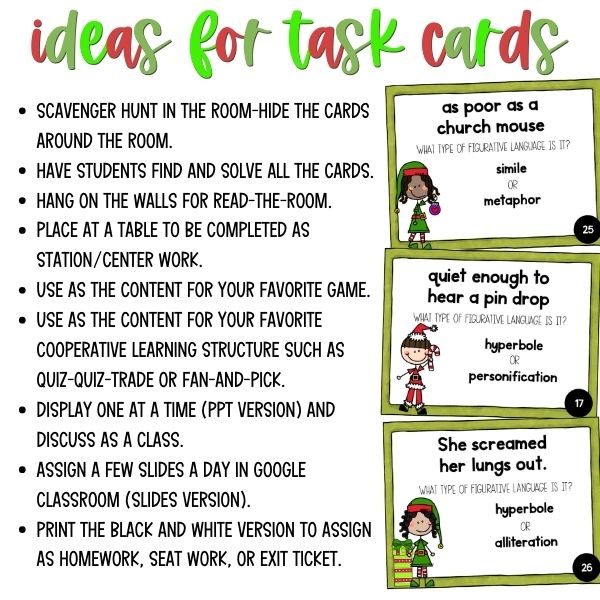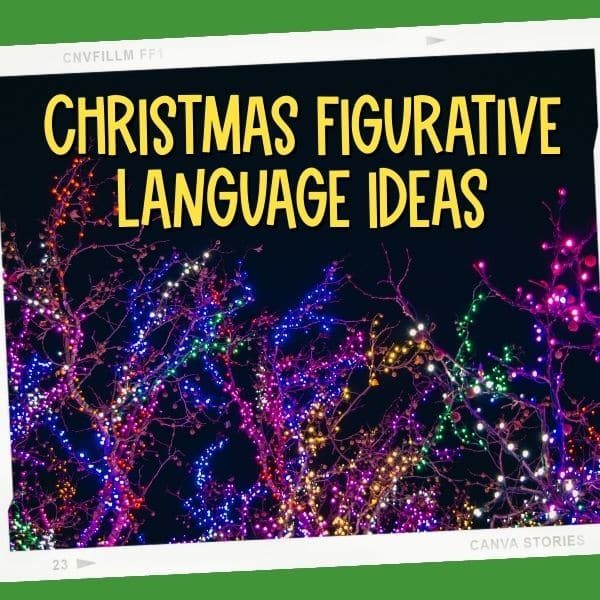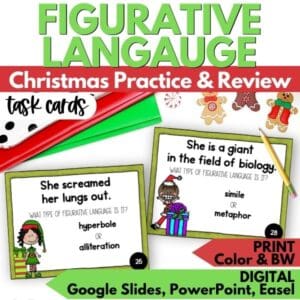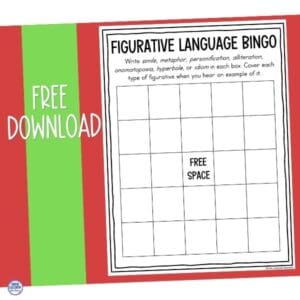Teaching a Christmas figurative language lesson can be a blast, especially when you incorporate the festive cheer of the holiday season. Let’s start by reviewing the different types of figurative language your students will need to master:
- Idiom: A phrase with a non-literal meaning. Example: “It’s raining cats and dogs.”
- Hyperbole: An exaggeration. Example: “I’m so hungry I could eat a horse.”
- Simile: A comparison using “like” or “as.” Example: “She’s as busy as a bee.”
- Metaphor: A direct comparison. Example: “Time is a thief.”
- Alliteration: A phrase with words starting with the same sound. Example: “Peter Piper picked a peck of pickled peppers.”
- Onomatopoeia: Sound effect words. Example: “The bacon sizzled in the pan.”
- Personification: Giving human traits to non-human things. Example: “The wind whispered through the trees.”
Now, let’s take a peek at some fun and inventive ways to teach and practice figurative language during the Christmas season.

1. Forage for Figurative Language in Christmas Books
One engaging way to teach Christmas figurative language is by having a figurative language hunt in Christmas-themed books. Choose popular Christmas stories and have students search for examples of idioms, hyperbole, similes, metaphors, alliteration, onomatopoeia, and personification. This activity not only helps students identify figurative language but also enhances their reading comprehension.
Example Books:
- “The Polar Express” by Chris Van Allsburg
- “How the Grinch Stole Christmas” by Dr. Seuss
- “A Christmas Carol” by Charles Dickens
2. Holiday-Themed Writing Prompts
Encourage students to write their own examples of figurative language using holiday themes. You can provide prompts like:
- Write a simile describing how Santa’s sleigh moves through the sky.
- Create a hyperbole about the size of a Christmas feast.
- Use personification to describe how a Christmas tree feels when it’s decorated.
This activity helps students apply their understanding of figurative language in a creative and personal way.
3. Christmas Figurative Language Task Cards
Create or use pre-made Christmas-themed task cards that practice identifying types of figurative language. Each card can have a sentence or phrase, and students need to identify which type of figurative language is used.

4. Festive Figurative Language Posters
Have students work in groups to create holiday posters that explain and give examples of different types of figurative language encouraging people to choose their assigned figurative language type as a present to put under the tree. This is also a great activity for exploring the idea of intended audiences and the persuasive language used in advertising. Each group can focus on a different type and use Christmas themes to make their posters colorful and engaging. Display these posters around the classroom as a helpful reference.
5. Figurative Language Bingo
Create a bingo game with a Christmas twist. Have students fill in this blank bingo card with the names of the different types of figurative language Then read an example and have identify the type to mark their card. Use Christmas-related phrases to keep the theme consistent.
Example Bingo Phrase:
- “The Christmas lights danced in the night” – (Personification).
- “The snow crunched under Santa’s boots.” – (Onomatopoeia)
- “They stacked the presents into a mountain of ribbons and bows.” – (Metaphor)
6. Figurative Language Christmas Carols
Rewrite traditional Christmas carols to include various types of figurative language. For example, change the lyrics to “Jingle Bells” to incorporate hyperbole, similes, and personification. Sing these new versions in class and discuss the figurative language used.
7. Christmas Figurative Language Bulletin Board
Create a bulletin board where students can add examples of figurative language they find or create throughout the holiday season. This interactive display can be a great way to showcase their learning and keep the excitement of discovering new figurative language alive.
Teaching figurative language can be incredibly fun, especially when you incorporate the festive spirit of Christmas. So, deck the halls with Christmas figurative language fun and watch your students’ understanding and enjoyment of figurative language grow!
For figurative language practice year round, you can incorporate a spiraled daily language review like these!






